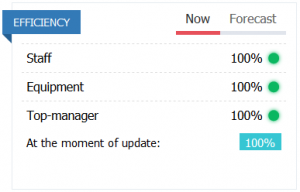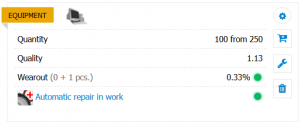Office/en
All production, trading and other enterprises are managed from the company's offices. In each region where the company has enterprises, a branch/regional office should be opened, otherwise the enterprises will not be able to work.
The efficiency of the office depends on a sufficient number of employees and their qualification, as well as on the installed equipment - computers. The more enterprises are managed by the office and the higher the level of advertising costs, the more employees are required for its effective work. On the other hand, the more employees there are in the office, the greater skill level is required from the Top manager.
Contents
OFFICE
Office size - the unit size in basic units - blocks (maximum number of employees for the current office size is shown in the brackets).
Rent expenses - weekly office expenses for the rent of premises. The cost of rent of an office is directly proportional to its size. The location of the city of the office also matters - the more economically developed the city and country, the higher the rental cost.
KPI
Office workload is an indicator that determines how loaded office “capacities” are. The load consists of three main factors: advertising of goods and shops, warehouses (the total area of enterprises of the “Warehouse” type in a given region) and it is loaded by total number of employees of controlled subdivisions (not only their total number, but also their qualifications, and type of enterprise, for example, 10 scientists will require more effort from the management office, compared to 10 miners). Advertising load in the office is calculated accordingly - the advertising costs of stores located in the region load office two times less than advertising of goods for the same amount. In both cases, the level of skill “Marketing” of the Top Manager, additionally reduces the load (by about 3% for each subsequent skill level).
Units under control - number of subdivisions in the region in which the office is located.
Number of workers - total number of workers in these enterprises.
Advertising expenses - the total current costs of branding for all advertising campaigns at the moment. It affects the level of Office workload.
Advertising efficiency - the efficiency of advertising in the office (only in it!) at the current level of advertising costs. An advertising efficiency of less than 100% means that the advertising budget is not spent perfectly, i.e. part of the money is wasted. It is determined by the ratio of the total amount of advertising costs and the maximum amount acceptable for the current level of “Marketing” skill of the Top Manager. Also, the effectiveness of advertising depends on the overall efficiency of the office (the indicator is dynamically recalculated with any change in the amount of advertising campaigns in the office, however, the CURRENT office efficiency (for the last turn) is taken into account).
Advertised products — A list of products advertised by the office.
EFFICIENCY
Staff efficiency - employee efficiency. In order to achieve 100% staff efficiency, it is necessary to: (a) ensure the minimum required level of staff qualifications; (b) further increase the management capacity of the office in order to meet the level of workload that the office bears.
Equipment efficiency - is the final indicator of the work of computers in the office. Depends on equipment wear and tear.
Efficiency of a Тop Мanager - the efficiency of office management by a Тop Мanager. Depends on how “Management” skill of the Top Manager corresponds to qualifications of the staff both in this particular office and in all the offices of the company as a whole.
Office Efficiency – level of efficiency achieved by the office by managing all of its subdivisions during last turn. Summary of 3 indicators: personnel efficiency, equipment efficiency and Top Manager efficiency. If office efficiency is less than 100%, the efficiency of all enterprises in the region may decrease.
EMPLOYEES AND SALARY
Number of employees - the current number of employees in the office.
Staff qualification - the current level of qualification of employees in the office (in addition, the average city qualification value and the required value, which is determined by the quality of computers, are indicated in brackets).
Salary of one employee - weekly salary of one employee. The average salary of office workers in the city is shown in brackets, which is equal to 150% of the average city wage level.
EQUIPMENT
Quantity - the current number of computers in the office. The optimal number of computers in the office is equal to the number of employees. If the current number of computers is less than the number of office employees, some employees will not be able to work. If the current number of computers is more than the number of office employees, some of the computers are not used, while only used computers are worn out, and wear and tear is applied for everything (the percentage of wear and tear is proportionally reduced).
Quality - an indicator of the quality of computers installed in the office. The higher the quality of the equipment, the greater the qualification of the personnel is required to work effectively with it. At the same time, each unit of equipment quality increases office capacity by 3%.
Wear and tear - the level of deterioration of equipment. The standard life of computers is 5 virtual years (weekly base wear is approximately 0.38%). In addition, the quality of the equipment itself affects the wear and tear (reduced by 1% per 1 quality of unit) and the ratio of the required and current qualifications of the personnel working with it (workers with less than required qualifications wear out equipment faster than more intelligent employees). Worn equipment directly affects its performance. Allowed wear and tear of computers in the office, not affecting the efficiency of the equipment, is set within 3%. The brackets indicate the wear of the equipment in units. Since depreciation is calculated as a percentage, partial wear and tear of a piece of equipment is possible - in this case, the “+1” marker is added to the value of the amount of the worn-out equipment. You can fix an incompletely worn computer only by completely replacing it.
TOP MANAGER
Total number of employees on profile skill - is the total number of employees of all offices of the company. It affects the effectiveness of the top manager.
Player skill level - the current level of “Management” skill of the Top manager. Determines the maximum possible number and qualifications of employees without loss of efficiency both in this particular office and in all offices of the company as a whole (an additional hint about the reserve of the current skill level compared to the minimum required can be indicated in the brackets, minimum - 0-25%, normal - 25-50%, good 50-100%, excellent more than 100%).
SUBDIVISIONS
In the "Units" tab, information is provided about all units managed by the region office. In addition to general information about the type of unit, its location and effectiveness, the share of the administrative load on the office, that each specific unit provides, is indicated. Often this information helps identify problematic enterprises that are causing an excess load due to improper management.
ADVERTISING
Information on current advertising campaigns is presented on the "Advertising" control tab, where the following indicators are presented:
- A summary table of promotions, including information about the advertised goods, their brand value, cities in the region where the ad is running, total costs and effectiveness;
- A detailed summary of each action: expenses per week, advertising channels (Internet, print media, outdoor advertising, radio, television), cities and effectiveness.
- Advertising Efficiency - The expected performance of an ad campaign next week. The optimal level of efficiency is 100%. If the effectiveness of advertising is less than 100%, the advertising budget needs to be reviewed, as part of the cost of advertising will be wasted.
ENERGY
A summary table of the energy consumption of enterprises in the region. The total energy consumption at all enterprises is indicated on the top line, and the total energy consumption for each city in the region is indicated in the city column. This information is very important when supplying enterprises with energy of their own production. Please note that a number of power plants have a restriction on the sale of electricity (region, city), therefore, when placing capacities, it is necessary to be guided by the correspondence of generation and consumption.
OTHER OFFICES
Information about all the offices of your company.





